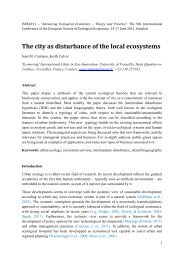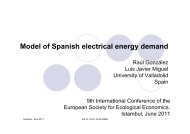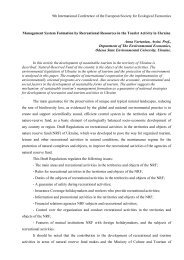Full Paper - ESEE 2011 - Advancing Ecological Economics
Full Paper - ESEE 2011 - Advancing Ecological Economics
Full Paper - ESEE 2011 - Advancing Ecological Economics
You also want an ePaper? Increase the reach of your titles
YUMPU automatically turns print PDFs into web optimized ePapers that Google loves.
Changes to the direct emissions impact associated with energy consumption by sector in the rest of<br />
the world regions (which will have an impact on any imported goods) could also be modelled in a<br />
similar energy scenario tool. The data availability for the rest of the world regions is limited at<br />
present to only the amount and type of fuel consumed by sector. Information on the energy services<br />
this fuel is used for is not available from GTAP. At present energy scenarios from the rest of the<br />
world regions will reflect emission reduction pathways consistent with 2 and 4 o C pathways.<br />
The direct industry emissions pathways in each scenario will be incorporated into the EEMRIO model<br />
which can then be used to calculate the emissions embedded within the supply chains of the goods<br />
and services produced using the Leontief inverse IO equations described in Appendix A.<br />
Consumer demand scenario tool extension<br />
The overall change in the level of household, government, capital investment and export<br />
consumption will be determined by an exogenous economic growth rate that can vary between<br />
scenarios. The UK final demand scenario tool will be used to model the breakdown of this overall<br />
level of consumption between the different categories and the different products within those<br />
categories. In addition it will also be used to model different levels of expenditure on domestic and<br />
imported goods and where those imports originate between the regions of the model (Other EU,<br />
Annex B and non-Annex B).<br />
Assumptions related to the changes in consumer demand will be determined through a combination<br />
of scenario workshops, expert advice and consumer focus groups. The consumption data generated<br />
by the consumer demand framework extension will feed into the EEMRIO which multiplies the<br />
consumption of goods and services by the estimated emissions embedded in the full supply chain of<br />
those goods or services.<br />
The overall modelling framework<br />
The complete modelling framework attempts to bring together appropriate aspects of some of the<br />
latest modelling techniques to add a new perspective to the policy, consumer and industry options<br />
available under different climate change scenarios. It will provide a flexible scenario quantification<br />
method that will enable the user to examine the both supply-side and demand-side policies and<br />
practices simultaneously. Using an EEMRIO as a basis means that the impacts of trade and<br />
consumption patterns can also be easily modelled within the framework, exploring wider issues of<br />
influence beyond national boundaries. The framework can also consider both strategies for<br />
territorial emission reductions through the decarbonisation of an energy system and the level and<br />
type of consumption that could be supported by this system in order to remain within a carbon<br />
budget. It will also add product level detail for specific products, which will generate detailed data<br />
for the scenario narrative and can be easily expanded to other products in the future.<br />
Data Sources and Limitations<br />
The limitations of the data sources and of the IO approach mean that the quantitative results from<br />
the model should be carefully interpreted. For example, the fine level of disaggregation between<br />
consumer categories could suggest the emissions impact behind the production of these goods and<br />
services is equally well disaggregated. This is not the case as firstly the attribution of emissions to<br />
sectors in the baseline is uncertain and in addition there is limited data upon which to base any<br />
judgement as to how for example the technological improvements of the insurance sector (GTAP 53)<br />
could differ from other financial intermediation (GTAP 52). Therefore a comparison of the relative<br />
13







